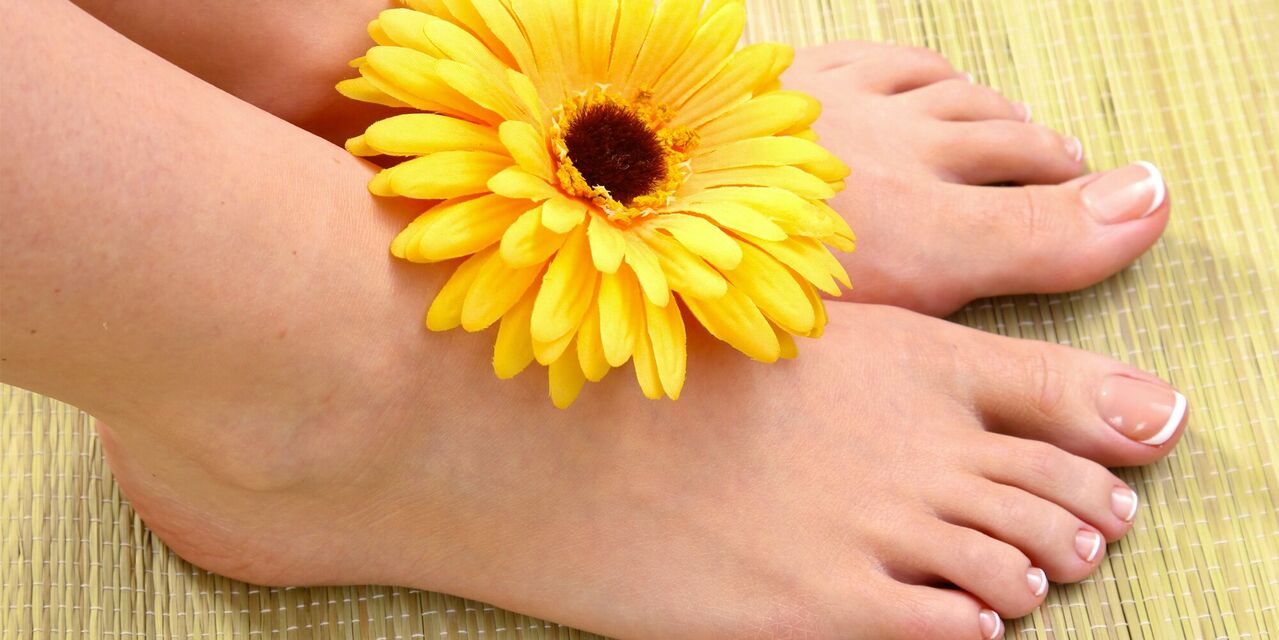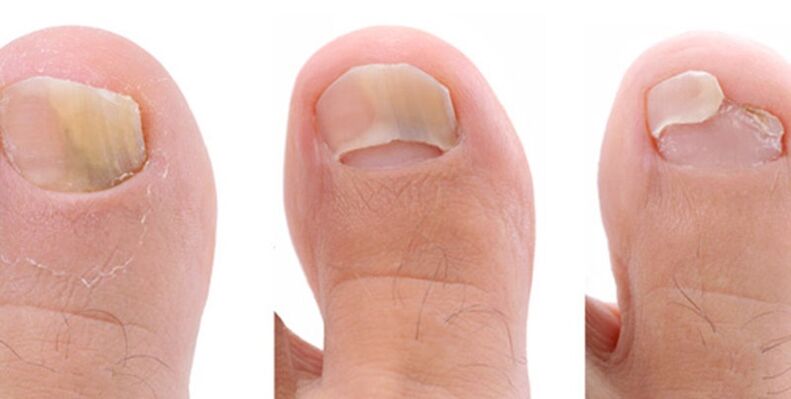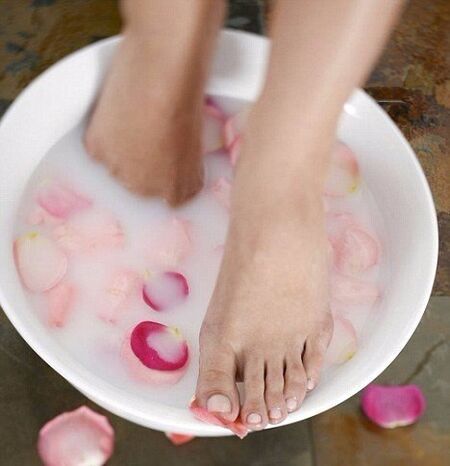Toenail fungus is a widespread infection caused by opportunistic and pathogenic fungal infections with dermatophytes. About 20% of the adult population suffers from nail mycosis and is practically undetectable in children.

The cause of the infection
The fungus is widespread in the environment, but damage to human nails and skin develops only under favorable conditions. With age, the acidic pH of the skin can change to alkaline, which is ideal for fungal growth. Infection usually occurs through contact, if the norms of personal hygiene are not adhered to, the source of infection can be a sick person or a commonly used object. Infections can occur in public places: swimming pools, saunas, gyms. And also in everyday life with the general use of slippers, socks, manicure accessories, towels and wipes.
Predisposing factors for onychomycosis infection are:
- decreased immunity;
- poor circulation in the feet, including when wearing tight shoes;
- excessive sweating;
- diabetes;
- obesiti;
- mechanical injuries to nails;
- deformities and anatomical features of the foot.
Signs of toenail fungus

Nail fungus is a very persistent infection, the early stages of the disease are expressed:
- discoloration of the nail plate, loss of luster;
- increased fragility;
- itching and irritation of the skin around the affected nail;
- pain at the site of the lesion, especially when wearing tight shoes;
- remove the nail part from the nail bed.
When the development and involvement of the entire nail plate in the process, new symptoms appear: the nail thickens and changes shape significantly.
Depending on the degree of nail damage, three types of onychomycosis are distinguished:
- Normotrophic - indicated by distortion of nail color from white to dark green. The color changes initially in spots or stripes and gradually covers the entire surface of the nail, while the thickness of the nail plate does not change and the luster remains.
- Hypertrophic - expressed by discoloration, loss of gloss and thickening and severe deformation of the nail. The nails are strongly peeled off and partially destroyed;
- Atropic - is reflected by discoloration, thinning and subsequent rejection of the affected area.
Which doctor treats fungus?
You can determine the infection yourself, but only a doctor can confirm the diagnosis. If you notice a change in nail color, increased fragility, you should consult a dermatologist. The doctor prescribes a microscopic study or diagnostic culture to confirm the diagnosis. A portion of the affected nail is taken for analysis or nearby tissue is scraped off. Timely detection of nail fungus greatly simplifies treatment and prevents the development of complications. Launched onychomycosis is dangerous, as it can cause mycotic eczema, aspergillosis, decreased immunity, infection of all nails, skin and other organs.
Toenail Fungus Treatment

How to treat onychomycosis is determined by the doctor depending on the degree of changes in the nail plate, the clinical form, the degree of hyperkeratosis and the length of the affected area. For treatment, local agents are used (ointments, drops, sprays, varnishes) and general agents (antimycotic drugs).
As a rule, with small changes in the nails, the drug is used for topical treatment. Before treatment with antifungal solutions, ointments, varnishes, the affected nail area should be removed surgically or with the help of keratolytic drugs. This is needed for better penetration of the antifungal drug deep into the damaged tissue, which allows you to get rid of the fungus more quickly.
Keratolytic drugs contribute to the softening of nails and their easy and painless removal, produced in the form of plasters, which include urea or salicylic acid:
- ureaplast;
- urea plaster with quinosol;
- patch quinosol-salicylic;
- onychoplast;
- quinosol-dimexide patch;
- mycospora (combined inventory).
Before applying the plaster, it is necessary to scrape the top layer of the nail, then apply a therapeutic mass and stick it with an adhesive plaster, changing the bandage every 1-2 days. Before the change, the affected area on the nail is removed with scissors and an antifungal agent is applied.
Antifungal creams, ointments and drops are:
- based on ketoconazole;
- clotrimazole derivatives;
- micanazole -based;
- oxycanazole derivatives;
- based on terbinafine;
- chloronitrophenol derivatives;
- based on naftifine.
Ointments, creams and drops are best applied on the open nail bed 2-3 times a day, until the final recovery of the nail. These drugs are active against most pathogens, but are unable to penetrate the entire depth of the nail plate.
Local antiseptics - solutions of iodine, dyes, quinosol, organic acids are often used in the treatment of nail fungus, if it is impossible to use other means. The main advantage, antiseptics are inexpensive and widely available. Local antiseptics, such as iodine, treat affected nails up to three times a day, for a month. When using the solution, it is advisable not to touch the surrounding skin to avoid burns. Burning sensations and tingling help to recognize the onset of exposure.
If local treatment is not effective, antimycotic tablets are also prescribed, prescribed by a specialist.
Properly selected combination therapies help cure advanced onychomycosis most quickly. Also, combination treatment with local and general therapies is prescribed for more than three affected nails, for people over the age of 50 and with slow nail growth. The use of combination therapy can significantly reduce the duration of treatment.
Treatment of fungus with folk remedies

For the preparation of antifungal agents at home, you can use - apple cider vinegar and herbal preparations:
- mix in equal parts vegetable oil and apple cider vinegar, moisten a cotton pad in the resulting solution, and apply on the affected nails for 4 hours, for convenience, you can fix the bandage with adhesive plaster. This procedure is performed daily for a month;
- for the treatment of neglected processes, a mixture of 9% vinegar with celandine helps, the resulting composition should be infused for a month. Then add 50 g of salt to it. The resulting product is used for foot baths 5-10 minutes before bedtime. It is important not to wipe your feet after a bath, but to let them dry on their own;
- to treat affected nails, you can use an alcoholic solution of propolis, juice or onion porridge, garlic. A mixture of lavender and tea tree oil also works well;
- decoction of herbs for foot bath: mix in equal proportions oak bark, calendula, ponytail, verbena. Pour 50 g of the resulting mixture with boiling water and keep in a water bath for about 15 minutes.
Prophylaxis
Fungal damage to nails can be easily avoided with good personal hygiene:
- It is necessary to wash your feet daily with an antiseptic agent.
- Dry your feet with a personal towel.
- Use pumice stone to exfoliate old skin, which is a good growth medium for fungus.
- Use medications that reduce foot sweat.
- Change socks, knee level and tights daily.
- Wear loose, comfortable shoes. Do not wear wet shoes.
- Wear shoes when visiting the pool and bathing.
- Do not use other people's shoes, slippers, socks, towels, manicure accessories.
- Use pharmacological preparations for protection before visiting the beach, swimming pool, sauna.
















